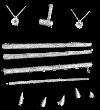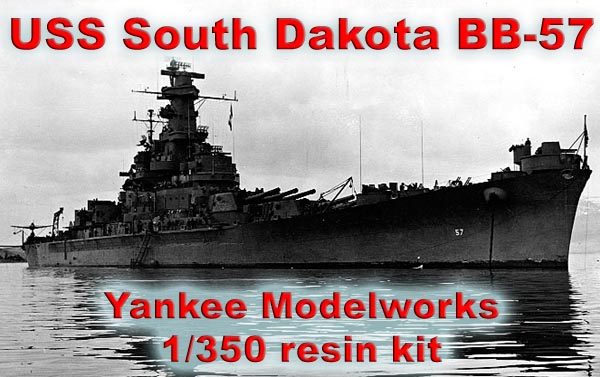| The USS South Dakota was the class leader
of a second new class of Fast Battleship to replace the aging prewar designs
then in service. Laid out like the preceding North
Carolina class, the four ships of this class were a little shorter
in length and had a more compact superstructure. The South Dakota or SoDak
as she was nicknamed was unique among her sisters in that she only had
eight twin 5" gun mounts. The SoDak was fitted with the latest search and
fire control radar and packed a tremendous punch from both the main and
secondary armament. The SoDak was rushed into service to help counter the
Japanese forces then roaming around the South Pacific. She proved her worth
as a Carrier escort at the Battle of Santa Cruz by shooting down a large
number of attacking aircraft and possibly saving the Carrier Enterprise
from air attack in spite of taking a direct hit on her number two gun turret
that effectively knocked that turret out. Hastily repaired she later
engaged Japanese surface ships at Guadalcanal without the full use of that
damaged turret. She then came under the combined attack of a host of Japanese
warships. Suffering a critical power failure at the same moment the South
Dakota received the concentrated fire from all of the enemy ships at once.
She sustained considerable topside damage but more importantly she drew
the enemies attention away from the USS Washington that was then able sink
the Battleship Kirishima. The SoDak withdrew from the battle and returned
home. She was hailed as the famous Battleship X, and got to take credit
for winning the battle. It was common practice at that time to censor the
names of ships in the battle zone. SoDak was home and thus was named in
many news reports as being a hero of the battle. Understandably this created
some bad blood among the crew of the USS Washington as they were not allowed
to be memtioned as the hero's that they were while they were still in the
war zone. In spite of this the South Dakota returned to the war repaired
and sporting even more anti aircraft guns. She spent most of her time as
a fast carrier escort lending her tremendous anti aircraft firepower to
protecting the carriers, but never again went toe to toe with another Japanese
warship. She survived the war only to end up being scrapped like her partner
the USS Washington, the two most important Battleships of the war. |
|
|
| HULL |
|
| Yankee Modelworks has produced this famous warships in her mid to late
war fit. This is a heavy duty kit, with a hull of almost 2 feet long and
with a solid resin hull cast in waterline style. This kit has been out
for quite a while but has been overlooked by the major ship modeling sites.
Since this is one of my all time favorite ships. it is only right to share
it with all of you. It is obvious from looking over this hull that Mike
Bishop has done his homework in researching this kit. He as correctly captured
the Alligator bow of this ship, as well as the other details. |
click images
to enlarge
 |
| Compare the images below to the Hasegawa
1/700 kit to see the differences. Unlike the smaller scale plastic
kit this hull has nice deck planking detail and chocks. There were a few
bubble holes on my hull but nothing a drop of super glue won't fix. The
only thing I don't like about this hull is the very thick over pour that
has to be sanded away. Thankfully YMK has inset this excess about an eighth
inch from the hull edge to help keep track of how much you are removing.
A separate lower hull is pretty well cast and other than a really thick
over pour looks real good. |
| SUPERSTRUCTURE |
|
| The superstructure parts are mostly cast as separate deck levels. This
should make back dating this kit to 1942 relatively easy. You might notice
that on some levels that the doors are cast open for a more realistic appearance.
The parts are all well cast with the exception of the resin over pour on
some parts. This is a bit thick and more work to sand flat. But the visible
areas of the various parts are well done and any extra sanding you have
to do will be well worth it. |
 |
|
|
| ARMAMENT AND DETAILS |
|
| The Big 16" guns with their 16" 45 caliber naval rifles
are well represented in a combination of resin and white metal. The turrets
have some really nice surface detailing. There are no casting gates to
remove as the turrets are poured from the bottom of the base. This eliminates
that extra cleanup that to remove casting gates in visible areas. Separate
blast bags really enhance these gun mounts. The cast metal barrels are
pretty nice, but not as impressive as machined gun barrels like those Steve
Nuttel is now producing. But you can always chuck these in a drill
and lightly sand them for a more uniform appearance. |
 |
 |
|
| The twin 5" 38 cal turrets are pretty well cast, with sighting
hoods and nice hatch detail. The gun barrels are pretty good but need a
bit of sanding to finish them up. Overall these turrets appear to be the
correct shape and size and are perfectly acceptable. These were state of
the art a few years ago but not as nice as some of the recent offerings
such as the new Paper
Lab 1/350 turrets.
The quad 40 mm are made up of cast metal bases and injection molded gun
barrels. The former is pretty good, but the gun barrels are simply the
best on the market. They are thin and nicely shaped and have long been
sought after by modelers seeking accurate gun barrels.
|
| Other metal parts include some really nice main and secondary
gun directors. Yankee Modelworks produces some of the best small gun directors
there are in this scale. You even get Pelorus mounts and different searchlights.
The life rafts are the typical YMW open bottom ones designed to work with
the separate PE net bottoms.
Kingfisher float planes are included. A bit of sanding to remove the flash
and these will be ready to go. |
|
|
| If you are building full hull then you will need the cast
metal propeller shafts with resin hubs. These will go nicely with the photo
etch blades included on the photo etch frets shown below. These shafts
can be cleanup using the same technique as mentioned for the main gun barrels. |
 |
 |
| PHOTO ETCH |
|
| Two photo etch frets are included. The first one includes the catapult
assemblies with some really cool relief etching on the deck. The aft crane
and radar's are nicely etched as are the other items such as 40 mm gun
shields and 20 mm gun mounts |
 |
|
|
| The second fret includes the railings and platform details as well
as some nice gun shields for the 20 mm guns. The railing are exceptionally
well done with drooping chain between the access locations. Check the thumbnails
below for more close ups. |
 |
|
|
| DECALS |
|
| Generic Hull numbers with flags and aircraft insignia are included
as well. |
 |
| INSTRUCTIONS |
|
| Instructions consist of a 12 page booklet with a series
of plan and elevation drawings show various parts placement. These are
nice but I would like to see some more 3D illustrations.
|
| CONCLUSIONS |

Conclusions:
This is a nice kit of one of the most important battleships of all time.
As near as I can tell the kit is quite accurate and except for the sometimes
excessive resin over pour it is a great kit. Everything you need is included
in this kit except paint and rigging. I would not recommend it for a beginner,
but anyone who has build plastic ships with photo etch should be able to
build this one. This is Stock Number: YKM-35099 with a retail price of
$ 549.00, a bit pricey but I have seen this kit on sale for less. Check
Yankee Modelworks
website for this ship and her sisterships as well as a host of other 1/350
subjects from WW2 to modern day subjects. |








